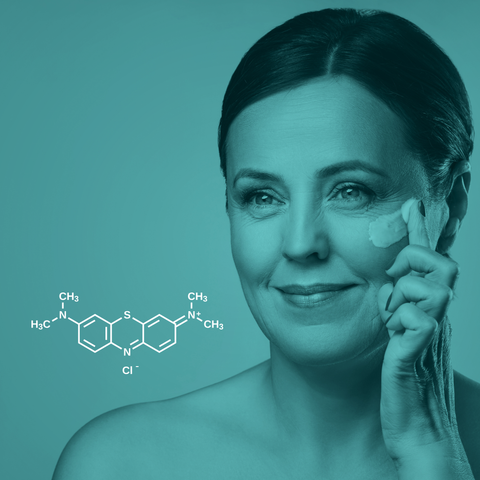
Methylene blue (MB) is a synthetic dye with a history dating back to the late 1800s, when it was first used in textile manufacturing. Since then it has been utilized in a range of applications across medicine, biology, and industry [1]. It has been recognized for its versatility as a redox indicator, medical stain, and therapeutic agent for conditions like methemoglobinemia [2,3], and possibly even breast cancer.
The skin is the largest and the most visible organ of the human body. Aged skin is biologically characterized by the flattening of the dermal-epidermal junction and a general atrophy of the extracellular matrix, with disorganized and reduced collagen and elastin [4,5]. There are two different types of skin aging, intrinsic and extrinsic, the former caused by physiological and the latter by environmental factors.
Intrinsic skin aging reflects the naturally occurring changes in the skin that occur as we age and is clinically manifested as fine wrinkles on the skin. Extrinsic skin aging is an accelerated form of this phenomenon due to exposure of the skin to sunlight and/or air pollution. It is demonstrated as dry, rough, pigmented, and abraded skin, especially on the face and hands. Although they present with different clinical features, both types of skin aging are partly due to the oxidative damage caused by free radicals.
In recent years the potential impact of MB on skin health, especially in anti-aging and skin regeneration, has garnered scientific attention. Today’s article explores the biochemical mechanisms, therapeutic potential, and applications of MB for skin health.
Chemical Properties of Methylene Blue
MB is a small, lipophilic molecule that is readily able to penetrate cellular membranes. In this manner, it can freely access intracellular compartments like mitochondria, lysosomes, and the cell nucleus [4]. It occurs as dark green crystals or crystalline powder with a bronze luster.
When dissolved in water, MB forms a deep blue solution commonly used as a dye. It is synthesized by oxidation of N,N-dimethyl-p-phenylenediamine with sodium dichromate in the presence of sodium thiosulfate, and further oxidation in the presence of N,N-dimethylaniline. MB hydrochloride is isolated by adding 30% hydrochloric acid and saturated sodium chloride solution to the dye, which is then filtered and washed with 2% sodium chloride solution [6].
In an oxidizing environment, MB is blue but turns colorless (leuco-MB) when exposed to a reducing agent. It acts as a redox-active compound, meaning it can alternate between oxidized (blue) and reduced (colorless) states [4]. This interesting property enables it to take part in electron transfer reactions in the mitochondria, thus influencing oxidative stress and cellular metabolism. The high permeability of MB in biological membranes permits it to freely enter intracellular compartments like mitochondria, lysosomes, and the nucleus.
Although there are numerous applications for MB in chemistry and everyday life, the dye is perhaps most famous as the first fully synthetic drug applied in medicine.
Anti-Aging and Skin Rejuvenation
Recent studies have demonstrated that MB exhibits anti-aging effects when applied topically. Aging skin is marked by increased oxidative stress, reduced collagen production, and diminished cell turnover. MB combats these effects by reducing oxidative stress and promoting mitochondrial function, which can improve skin elasticity, hydration, and overall appearance.
Research conducted in vitro (in lab cultures) and ex vivo (in human skin samples) has shown that MB increases the production of collagen, a vital protein for skin firmness and elasticity. The compound also appears to improve the activity of fibroblasts (cells responsible for collagen synthesis) and reduce the expression of p16, a biomarker of physiological aging [4]. By promoting healthier cellular activity and reducing oxidative stress, MB has been suggested as an ingredient in anti-aging skin care products.
One of MB’s key mechanisms is its ability to interact with mitochondria, the energy-producing factories within cells. By shuttling electrons within the electron transport chain, MB enhances ATP production (the cellular energy currency of life) and reduces reactive oxygen species (ROS), which are responsible for oxidative damage and aging effects on the skin. This dual role as an antioxidant and metabolic enhancer underpins many of the benefits of MB for the skin.
Regenerative and Wound Healing Properties
Another promising application of MB is in wound healing and skin regeneration. When the skin is injured, oxidative stress increases as immune cells generate ROS to combat pathogens. While this is a natural part of the healing process, excessive ROS can damage healthy tissue and slow healing. By reducing oxidative stress, MB facilitates a balanced healing environment [7,8].
Recent experimental work in rats has shown that administration of MB following burn injury reduced necrosis progression, likely due to a reduction in oxidative stress owing to MB’s antioxidant action [9].
Moreover, MB's impact on cellular energy production (through enhanced ATP generation) may promote faster cell migration and division, which are crucial for wound closure. Its role as an anti-inflammatory agent may also prevent and heal chronic wounds [10] or excessive scarring.
Antimicrobial Properties and Skin Disinfection
One of MB’s oldest medical applications is as an antimicrobial agent. This application extends to skin health, especially in combating bacterial, fungal, and viral pathogens. MB has been shown to inhibit the growth of Streptococcus mutans, the bacteria responsible for dental plaque, and reduce bacterial load on the skin when used in conjunction with photodynamic therapy [10-12]. In this process, MB absorbs specific wavelengths of light and transfers energy to oxygen molecules, generating ROS that can damage microbial cell walls and DNA. Photodynamic therapy using MB has been explored for skin infections, acne, and even the decontamination of personal protective equipment (PPE) during the COVID-19 pandemic [13].
Safety and Side Effects
MB is generally considered safe when used at low concentrations in topical preparations. However, as a strong dye, it can stain the skin temporarily, leaving a bluish tint that fades after a short time.
Caution should therefore be advised when using higher concentrations of MB that may cause skin irritation or discoloration. Research is currently ongoing to understand the ideal dosage and formulations for safe, long-term use in skincare products.
Conclusion
Methylene blue has a long history of applications since its discovery over a century ago. Its anti-aging, antimicrobial, antioxidant and regenerative properties offer substantial promise for modern skincare formulations. Given its ability to enhance mitochondrial function, promote collagen production, and reduce oxidative stress, MB addresses multiple features of the skin aging process. Although more research is needed to optimize its use in cosmetic applications, these attractive properties of MB position it as an important component for promoting skin health and wellness.
If you're interested in trying out methylene blue on your own skin, check out Troscriptions' limited-release collaboration skin spray here! It's a clinically formulated face mist designed to energize skin at the cellular level. Powered by advanced longevity science, it revives mitochondrial function, enhances collagen production, and shields against environmental and oxidative stress.
If you're interested in trying out methylene blue on your own skin, check out Troscriptions' limited-release collaboration skin spray here! It's a clinically formulated face mist designed to energize skin at the cellular level. Powered by advanced longevity science, it revives mitochondrial function, enhances collagen production, and shields against environmental and oxidative stress.
References
[1] R.H. Howland, Methylene Blue: The Long and Winding Road from Stain to Brain: Part 1, J Psychosoc Nurs Ment Health Serv 54 (2016) 21–24. https://doi.org/10.3928/02793695-20160818-01.
[2] R.S. Pushparajah Mak, E.L. Liebelt, Methylene Blue: An Antidote for Methemoglobinemia and Beyond, Pediatr Emer Care 37 (2021) 474–477. https://doi.org/10.1097/PEC.0000000000002526.
[3] A. Skold, D.L. Cosco, R. Klein, Methemoglobinemia: pathogenesis, diagnosis, and management, South Med J 104 (2011) 757–761. https://doi.org/10.1097/SMJ.0b013e318232139f.
[4] Z.-M. Xiong, M. O’Donovan, L. Sun, J.Y. Choi, M. Ren, K. Cao, Anti-Aging Potentials of Methylene Blue for Human Skin Longevity, Sci Rep 7 (2017) 2475. https://doi.org/10.1038/s41598-017-02419-3.
[5] A. Gosain, L.A. DiPietro, Aging and Wound Healing, World j. Surg. 28 (2004) 321–326. https://doi.org/10.1007/s00268-003-7397-6.
[6] A.P. Gureev, I.S. Sadovnikova, V.N. Popov, Molecular Mechanisms of the Neuroprotective Effect of Methylene Blue, Biochemistry Moscow 87 (2022) 940–956. https://doi.org/10.1134/S0006297922090073.
[7] H. Xue, A. Thaivalappil, K. Cao, The Potentials of Methylene Blue as an Anti-Aging Drug, Cells 10 (2021) 3379. https://doi.org/10.3390/cells10123379.
[8] K.Y. Woo, J. Heil, A prospective evaluation of methylene blue and gentian violet dressing for management of chronic wounds with local infection, International Wound Journal 14 (2017) 1029–1035. https://doi.org/10.1111/iwj.12753.
[9] M.J. Rosique, R.G. Rosique, F.M. Faria, C.C. Oliveira, J.A. Farina, P.R.B. Évora, Methylene blue reduces progression of burn and increases skin survival in an experimental rat model, Burns 43 (2017) 1702–1708. https://doi.org/10.1016/j.burns.2017.04.021.
[10] X. Shen, L. Dong, X. He, C. Zhao, W. Zhang, X. Li, Y. Lu, Treatment of infected wounds with methylene blue photodynamic therapy: An effective and safe treatment method, Photodiagnosis Photodyn Ther 32 (2020) 102051. https://doi.org/10.1016/j.pdpdt.2020.102051.
[11] J.C.M. Soares, M.T. Luiz, J.A. Oshiro Junior, J.F. Besegato, P.B.G. de Melo, A.N. de S. Rastelli, M. Chorilli, Antimicrobial photodynamic therapy mediated by methylene blue-loaded polymeric micelles against Streptococcus mutans and Candida albicans biofilms, Photodiagnosis Photodyn Ther 41 (2023) 103285. https://doi.org/10.1016/j.pdpdt.2023.103285.
[12] M. Pérez, P. Robres, B. Moreno, R. Bolea, M.T. Verde, V. Pérez-Laguna, C. Aspiroz, Y. Gilaberte, A. Rezusta, Comparison of Antibacterial Activity and Wound Healing in a Superficial Abrasion Mouse Model of Staphylococcus aureus Skin Infection Using Photodynamic Therapy Based on Methylene Blue or Mupirocin or Both, Front. Med. 8 (2021) 673408. https://doi.org/10.3389/fmed.2021.673408.
[13] J. Hepburn, S. Williams-Lockhart, R.J. Bensadoun, R. Hanna, A Novel Approach of Combining Methylene Blue Photodynamic Inactivation, Photobiomodulation and Oral Ingested Methylene Blue in COVID-19 Management: A Pilot Clinical Study with 12-Month Follow-Up, Antioxidants (Basel) 11 (2022) 2211. https://doi.org/10.3390/antiox11112211.





Comments (0)
There are no comments for this article. Be the first one to leave a message!